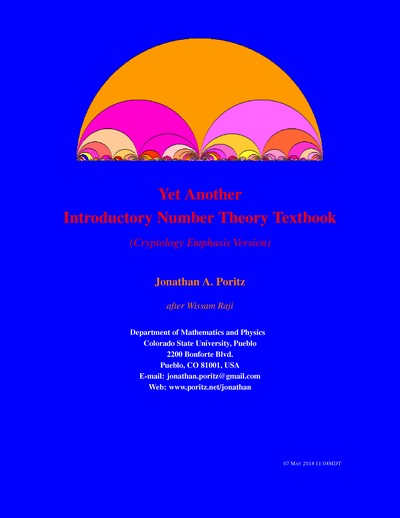
Yet Another Introductory Number Theory Textbook (Cryptology Emphasis Version)
An introduction to number theory covering basics, congruences, primes, the Chinese Remainder Theorem, Wilson's Theorem, Fermat's Little Theorem, Euler's Phi function, etc.
Tag(s): Number Theory
Publication date: 07 May 2014
ISBN-10: n/a
ISBN-13: n/a
Paperback: 128 pages
Views: 42,167
Type: Textbook
Publisher: Lulu.com
License: Creative Commons Attribution-ShareAlike 4.0 International
Post time: 15 Jun 2017 07:00:00
Yet Another Introductory Number Theory Textbook (Cryptology Emphasis Version)
 An introduction to number theory covering basics, congruences, primes, the Chinese Remainder Theorem, Wilson's Theorem, Fermat's Little Theorem, Euler's Phi function, etc.
An introduction to number theory covering basics, congruences, primes, the Chinese Remainder Theorem, Wilson's Theorem, Fermat's Little Theorem, Euler's Phi function, etc.
Publication date: 07 May 2014
ISBN-10: n/a
ISBN-13: n/a
Paperback: 128 pages
Views: 42,167
Document Type: Textbook
Publisher: Lulu.com
License: Creative Commons Attribution-ShareAlike 4.0 International
Post time: 15 Jun 2017 07:00:00
Share — copy and redistribute the material in any medium or format
Adapt — remix, transform, and build upon the material for any purpose, even commercially.
The licensor cannot revoke these freedoms as long as you follow the license terms.
Click here to read the full license.
Jonathan Poritz wrote:This version of YAINTT has a particular emphasis on connections to cryptology. The cryptologic material appears in Chapter 4 and §§ 5.5 and 5.6, arising naturally (I hope) out of the ambient number theory. The main cryptologic applications – being the RSA cryptosystem, Diffie-Hellman key exchange, and the ElGamal cryptosystem – come out so naturally from considerations of Euler’s Theorem, primitive roots, and indices that it renders quite ironic G.H. Hardy’s assertion [Har05] of the purity and eternal inapplicability of number theory.
Note, however, that once we broach the subject of these cryptologic algorithms, we take the time to make careful definitions for many cryptological concepts and to develop some related ideas of cryptology which have much more tenuous connections to the topic of number theory. This material therefore has something of a different flavor from the rest of the text – as is true of all scholarly work in cryptology (indeed, perhaps in all of computer science), which is clearly a discipline with a different culture from that of "pure" mathematics. Obviously, these sections could be skipped by an uninterested reader, or remixed away by an instructor for her own particular class approach.
Tweet
About The Author(s)
Jonathan A. Poritz (@poritzj) is Associate Professor in the Department of Mathematics and Physics and Data Analyst in the Center for Teaching and Learning, both at Colorado State University – Pueblo, in Pueblo, Colorado, USA.

Jonathan A. Poritz (@poritzj) is Associate Professor in the Department of Mathematics and Physics and Data Analyst in the Center for Teaching and Learning, both at Colorado State University – Pueblo, in Pueblo, Colorado, USA.